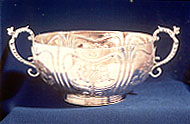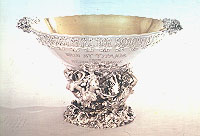|
|
Elegant
Plate: Three Centuries
of Precious Metals in New York City
by
Connie Hershey
|

Silver
paneled bowl made by Gerrit Onckelbag, 1691-1732.
MCNY, 72.88.2.
|
|
I've
always blamed it on Frank Sommer. When I was a
fellow, Dr. Sommer was working on enhancing DAPC's
holdings. He assigned each of us an area of the
decorative arts, and ordered us to comb the sources
for visuals that recorded documented examples. My
assignment was pre-1750 New York silver, and I've
been addicted ever since. It's a mild case: I don't
have to own the stuff. But I feed my habit by
looking at it whenever I can; and my bookshelves
are weighted down with silver books and exhibition
catalogues.
|
This
past summer saw the mounting of an exhibition at the Museum
of the City of New York that provided further proof--if
anyone needed it--that New Yorkers have always known how to
flaunt what they've got. Deborah Dependahl Waters (WPEAC
'71) the museum's Curator of Decorative Arts and
Manuscripts,assembled about 150 objects of silver and gold
made by/for citizens of New York over three centuries. From
the smallest (gold rings) to the largest (an eye-filling
presentation ewer), the articles were selected to illustrate
the ways in which precious metals have always been essential
to wealthy New Yorkers: assisting at their tables, marking
their achievements, commemorating the landmark events of
their lives, and letting the world know they
mattered.
|

Silver pitcher
(one of two) made by Tiffany & Co., N.Y., 1859.
MCNY, 55.257.5.
|
|
Because
exhibition space at MCNY is severely limited, its
exhibitions can't indulge in the spatial hyperbole
permitted some larger institutions. The objects
were ranked in dazzling profusion in unassertive
cases; and the first impression of the exhibition
area recalled illustrations from Frank Leslie's
glorious guidebook to the 1876 Centennial: nothing
succeeds like excess. But as a viewer approached,
and recognized one object after another, the
impression of excess was replaced by one of
magnitude. Here was a comprehensive collection; one
that was achieving its goal of representing a
community's tastes and preferences over time. And
the bounty in the cases represented only about a
third of the museum's legendary precious metals
holdings!
The
exhibition closed at the end of September, but its
soul lives in a two-volume catalogue. The volumes
document a vibrant network of research whose roots
reach back almost a century, to the 1910
publication of R. T. Haines Halsey's Catalogue
of an Exhibition of Silver Used in New York, New
Jersey and the South. More than two hundred
pieces of New York silver were represented in that
work, documenting the love of New York's great
families for precious metals. Then C. Louise Avery
mounted An Exhibition of Early New York
Silver at the Met in 1930. I think it is fair
to say that those two catalogues are the Domesday
Book of early New York silver.
|
As the
century continued, a series of scholars built on that
beginning. In 1926, V. Isabelle Miller left the Met to help
create the Museum of the City of New York. For almost forty
years she enlarged the museum's holdings, published them,
and encouraged members of New York's historic families to
present ancestral objects to the museum. Her two major
exhibitions, in 1937 (Silver by New York Makers) and 1962
showed the public the extraordinary range of silver made by
and for New Yorkers And each exhibition brought additional
objects to the museum's collections. Margaret D. Stearns,
who succeeded her, expanded the research base and provided
the biographical data that filled out the names dates and
makers' marks. After her death in 1989, her will stipulated
that her executor present to the museum her voluminous files
of silver research and the relevant part of her library.
Waters, who had worked with Stearns and then succeeded her,
is a formidable researcher, tenacious in her pursuit of
information and objects.
Elegant
Plate is monumental in several senses: massive in size;
broad in scope and comprehensive in the information it
provides. And it looks good, too! All of us know that
photographs of objects can never compare to the objects
themselves. But the best object catalogues use a combination
of paper, printing and image to give your mind the illusion
of having seen the thing itself. Though silver is
particularly treacherous for photographers, the
illustrations in this work run a very fine line: conveying
maximum information about the piece without providing images
that are clinical. Waters has boldly included ten color
plates; primarily recording objects that are gold or a mix
of materials. It was an excellent strategy, since it reminds
the reader that even the most excellent black and white
photographs don't convey the full range of tones to be seen
in articles made of metals.
|
There
are three degrees or varieties of information in
this book: The first is the hard data-the
photographs, measurements, marks, and bibliographic
record for each piece. Beyond that are the
excellent catalogue entries that are much more than
descriptions-they represent a distillation of
decades of research on the part of three gifted
curators. Finally, the introductory essays by three
scholars of American silver-Waters, Kristin
McKinsey (WPEAC '84), and Gerald Ward-address three
aspects of the study of this subject. Waters
discusses the ways in which silver was designed,
displayed, advertised, and sold over two centuries
in New York. McKinsey uses the interrelated
silversmithing families of LeRoux and VanDyck as
vehicles for a fine study of the craft as practiced
in NewYork. And Ward analyzes the important but
often neglected role played by presentation silver
in individual, family, and societal
relationships.
For
many of us, the decisive factor in purchasing a
weighty book is the embarrassingly simple one of
"shelf space." In this reviewer's opinion, the
decision is equally simple. If you aim for a
comprehensive library of American silver,
Elegant Plate demands space on your shelves
whether you measure it by the inch or by the
pound.
|
|

Silver tankard made by Cornelius Kierstede, ca.
1700. MCNY, 73.25.
|
|

Goelet Prize for Sloops, 1889. Made by
Tiffany & Co., N.Y. MCNY,
M39.1.1.
|
|
Copies
of Elegant Plate are available through many
of the usual suspects. It is offered by such
publications as The Magazine Antiques or can
be obtained from the bookstores of the Museum of
the City of New York (212-534-1672, www.mcny.org )
and Winterthur and will certainly appear in many
more museum shops and bookstores. Several on-line
book dealers are also carrying it.
Deborah
Dependahl Waters, ed., Elegant Plate, Three
Centuries of Precious Metals in New York City
(New York: Museum of the City of New York,
distributed by the University Press of New England,
2000) ISBN # 0-910961 (the set).
Connie
Hershey is a past president of the society
and a 1966 graduate of the WEAPC
program.
|
|
|




